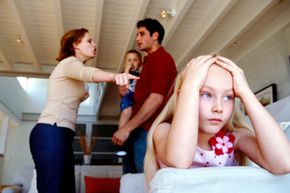 “Children can suffer from violence even if they aren’t the direct victim.Goodshoot/Goodshoot/Thinkstock
“Children can suffer from violence even if they aren’t the direct victim.Goodshoot/Goodshoot/Thinkstock
Scientists, psychologists and other experts have been studying how violence affects children for several decades. On the surface, the effects may seem obvious. Children who are victims of or witnesses to violence may experience behavioral and developmental problems. But the issue is far more complex than a simple cause-and-effect relationship.
Our personalities are complicated — you can’t simply point to a specific moment as the genesis for a particular trait or flaw. We’re the product of thousands of influences and we encounter new ones each day. While there’s no question that exposure to violence can and does affect children negatively, it’s difficult to measure the extent of the effect. Is a child’s aggression the result of witnessing violence or could it be the result of growing up in a poor community or in an unsupportive home environment? Did the child suffer other forms of abuse or neglect? It’s challenging, if not impossible, to determine how much of an effect violence has on a child’s behavior and personality.
Even so, there are dozens of studies that indicate children who suffer or witness violence may experience short- and long-term negative effects. The severity of the child’s reaction depends upon several factors, including the child’s age, gender, community and support system. The intensity, frequency, duration and nature of the violence also matter. Some children may experience more severe effects than others with a similar background. There’s no cheat sheet to explain exactly what will happen to any individual child.
It’s important to conduct more research and gather more data. By creating standard definitions for terms like violence, domestic violence and community, researchers can create a more meaningful picture of how violence can affect children. It’s also important to find ways to measure these effects and to take all the factors into account. By narrowing the focus of each study, we may be able to develop the best methods to counsel and treat children exposed to violence as well as develop strategies for violence prevention.
Let’s look at some of the short- and long-term effects violence can have on children.
Effects of Violence
It’s unfortunate that children may encounter violence at all. Two of the more common types of violence children may experience are domestic violence and community violence. In general, domestic violence covers violent acts within the child’s family group. That may include the child’s biological relatives or any stepparents or other people living in the child’s home.
Community violence seems simple enough to define on the surface — it’s violence that happens within a child’s community. But defining the actual community is more difficult — is it the neighborhood? Is it a certain measurable radius around the child? And if a child doesn’t experience the violence directly as a victim or witness, what effect might that have? These are questions psychologists and childcare specialists have to answer to create meaningful studies.
Young children exposed to domestic violence react differently than older children in the same situation. Infants and toddlers may find it difficult to trust others after witnessing violence or show a lack of energy or enthusiasm. Slightly older children may develop problems with aggression, including bullying or being cruel to animals. School-age children who’ve witnessed domestic violence may model their views on gender roles based on what they’ve seen. This could lead to boys growing up to be abusive toward women or girls entering sexual relationships early or tolerating an abusive partner.
Children who witness or experience community violence may be more likely to join a gang or abuse drugs. In turn, that can lead to an increased risk of injury, disease or death. They can also show symptoms of post traumatic stress disorder (PTSD).
Other symptoms may include developmental problems — some research shows a possible connection between violence and learning disabilities. Children may also experience sleep disorders or become insecure and anxious. They may develop self-esteem issues as well. And it’s possible that children who are victims or witnesses to violence may themselves become violent in adulthood, creating a cycle of violence that’s difficult to break.
Children’s health is an important issue. We need more research to narrow down the variables to determine how violence affects children so that we can treat both the symptoms and the underlying cause. It’s important to remember that violence has a negative impact. But it’s just as important to admit that without knowing the nature and extent of that impact, our efforts to help these children won’t be as effective as what they need and deserve.
Learn more about human behavior by following the links on the next page.
Lots More Information
Related Articles
- Understanding Childhood Disabilities
- Understanding Family Structures and Dynamics
- How Post-traumatic Stress Disorder Works
- How Oppositional Defiant Disorder Works
More Great Links
- National Center for Children Exposed to Violence
Sources
- Analytical Sciences. "Children Exposed to Violence: Current Status, Gaps and Research Priorities." NICHD Workshop on Children Exposed to Violence. Washington, D.C. July 24-26, 2002. (Aug. 10, 2010) http://www.nichd.nih.gov/publications/pubs/upload/children_violence.pdf
- Baker, Linda L., et al. "Children Exposed to Violence." Centre for Children and Families. 2002. (Aug. 11, 2010) http://www.lfcc.on.ca/police-us.PDF
- Edleson, Jeffrey L. "Children’s Witnessing of Adult Domestic Violence." University of Minnesota. May 6, 1997. (Aug. 11, 2010) http://www.ncdsv.org/images/ChildrenWitnessingAdultDV.pdf
- Finkelhor, David, et al. "Children’s Exposure to Violence: A Comprehensive National Survey." U.S. Department of Justice. October 2009. (Aug. 10, 2010) http://www.ncjrs.gov/pdffiles1/ojjdp/227744.pdf
- National Center for Children Exposed to Violence. (Aug. 10, 2010) http://www.nccev.org/
- Unicef. "Behind Closed Doors." Unicef: Child Protection Section. 2006. (Aug. 10, 2010) http://www.unicef.org/media/files/BehindClosedDoors.pdf
- Vuong, Linh. "Children Exposed to Violence." Focus. August 2009. (Aug. 11, 2010) http://www.nccd-crc.org/nccd/dnld/Home/focus0809.pdf



































